PR-6170RUK Science A STEM Approach - Primary 1
You also want an ePaper? Increase the reach of your titles
YUMPU automatically turns print PDFs into web optimized ePapers that Google loves.
Living Things<br />
LIVING THINGS HAVE NEEDS<br />
Lesson 2<br />
Lesson Plan<br />
Introduction:<br />
1. As a class, display the interactive activity at and choose pupils to<br />
click on a living thing in the scene to take a photograph. Pupils explain their reasoning behind each<br />
choice in terms of its basic needs. Alternatively, pupils can brainstorm living things and explain<br />
their needs orally.<br />
Development:<br />
2. As a class, ask pupils What do humans need to survive? Do they need more than just food, air<br />
and water? Brainstorm things that humans need to survive and write pupils’ ideas on an A3 piece<br />
of paper to create a poster. Note: Add all ideas, regardless of whether they are a need or a want.<br />
Leave space at the bottom of the page to write a few sentences about humans wants and needs at<br />
the end of the lesson.<br />
3. Watch the online video Needs vs Wants at . Alternatively, display the<br />
posters on page 10 to show examples of wants and needs. Using a think-pair-share, pupils answer<br />
the questions What is a need? and What is a want?<br />
4. Review the list of needs written on the ‘What do humans need to survive?' poster and put a cross<br />
through any that pupils think are wants, not needs. Discuss that as humans we have five basic<br />
needs: air, food, water, sleep and protection. Write these keywords on the whiteboard.<br />
5. Individually, pupils reflect on how they meet their five basic needs and present them using the<br />
circle booklet template on page 11. Pupils cut around the outside of the whole booklet.<br />
Note: Booklets may be cut out by adult helpers prior to the lesson, if required. Pupils turn their<br />
booklet over and copy the five basic needs from the whiteboard: air, food, water, sleep and<br />
protection. Pupils fold each circle inwards to create a booklet. When this is complete, pupils open<br />
one circle at a time and draw images on the inside of each circle to show how they meet each<br />
particular need in their lives.<br />
Differentiation<br />
• Less able pupils can have the booklet prepared for them with the five needs written on the<br />
outside. Adult helpers can assist pupils to think of how they meet their needs at home.<br />
• More able pupils should be encouraged to write a short sentence about how they meet their<br />
needs inside each circle; for example, inside the shelter circle pupils may write, I live in<br />
a house.<br />
6. When the circle booklets are completed, select pupils to share their pages with the class.<br />
Reflection:<br />
7. As a class, reflect on what humans want and need by referring to the A3 poster created in the<br />
development. At the bottom of the page, write the sentence starters Humans need … and Humans<br />
want … Ask pupils to name the things that humans need to survive and name some examples<br />
of our wants to complete the sentences. Note: Keep this poster accessible or on display for later<br />
lessons.Viewing sample<br />
www.prim-ed.com – Prim-Ed Publishing 978-1-912760-14-5 Infants<br />
<strong>Science</strong>:<br />
A <strong>STEM</strong> AP<strong>PR</strong>OACH<br />
9


















